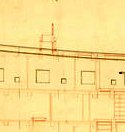-
Posts
841 -
Joined
-
Last visited
Content Type
Profiles
Forums
Gallery
Events
Everything posted by michaelpsutton2
-
She was copper sheathed below the waterline
-
There is a book "Mutiny on thee Bounty" br Peter Fitzsimmons. The cover painting is very close to what I would think
-
I believe that the cover of the "Anatomy of the Ship" volume on the Bounty is about as good a guess as you will get. There are no contemporary pictures are verbal descriptions. The blue color on the replica from the 60's was a complete fantasy. I would go with varnished hull. Black wale. Yellow rails and quarter badge and black quarter deck bulwarks. The current replica has the bottom most plank of the bulwarks removed and the stanchions painted red. I am not sure of that at all. The plans made when she was converted for the trip do not show that feature and seem to suggest sold bulwarks on the quarterdeck and an open rail forward of that in the waist. The current replica is red below the waterline and that is definitely out. Look at pic's of merchant ships of the period as well as 6th rates
-
Your machine work is amazing. I do not think I have seen you equal working in metals on this site. Do you know where there are more complete plans for this vessel. The Historic American Engineering Record one are rather incomplete.
- 281 replies
-
- falls of clyde
- tanker
-
(and 2 more)
Tagged with:
-
In port and whenever not being used at sea upper yards would be lowered as far as possible. Generally the lower yards and the lower topsail yards if the ship had double topsails were fixed in place. It would help lower the center of gravity for them to be closer to the waterline. That means in harbor less chance of rolling over or capsizing when cargo has been taken out and she is "riding high". At sea lowering all possible yards. reduced strain on the masts and rigging. Remember the upper yards and associated gear could weigh tons. All that weight shifting back and forth as the ship rolled with the waves could bring on failures. In preparation for really extreme weather conditions the upper sections of the masts themselves could be struck.
-
If anyone sees it on air in the US please post it!
-
It is my general impression that the US Navy did not employ brace pendants. The brace blocks in all of the sail plans I can find are seized directly to the yard arms at the shoulder. Anybody know anything about this?
-
nice
-
If you peruse the plans on the NMM website, you will see that for some ships oar ports are not shown on the sheer plans but appear only on the inboard profiles
-
What frigate is shown in the pic above?
-
Each generation was at least in theory an improvement on the previous. So in a strictly arbitrary sense the very last should have the benefit of past mistakes and be the best. The last generation of wooden , pure sail, warships were never presented with the opportunities to earn honors in the large scale fleet actions that their ancestors did. It would seem as the 19th century wore on, navies were more and more hesitant to risk their best (most expensive) ships in combat. The "fleets in being" served as a deterrent and spent thier lives either in ordinary or parading from port to port "showing the flag"
-

Rigging Question - Virginia Privateer
michaelpsutton2 replied to David Lester's topic in Masting, rigging and sails
I would include the jackyard even if it was not normally deployed carried without the sail. It speaks to the loftiness of the sail plans that this class of vessel was noted for. Many models include items of rigging that are associated with sails even when the sails are not represented, buntlines and brails to name bit a few. -

Rigging Question - Virginia Privateer
michaelpsutton2 replied to David Lester's topic in Masting, rigging and sails
I had a question with regards to the rigging of the fore t'gallant sheets on the Pride of Baltimore II. The sail is substantially shorter than the topsail yard and I did not understand how the sheets could lead to blocks at the yardarms. I emailed her captain, Miles I think, and rec'd a prompt and very informative reply. Capt Mile told me there are thimbles seized at the yardarms on long pendants that reach in to where the sail is.. The sheets lead through the thimbles down aft of the sails. The t'gallant yard is hoisted with the sail already bent to it and set flying (no braces). The sail in never furled on the yard, instead the whole assembly is brought down on deck. This is why there are no pictures of her with the t'gallant yard unless the sail is set. Capt Miles said he in not an expert on how it happens. He just issues the command set the t'gallant and the crew takes care of it. More to your problem, the "Pride" also carries a jackyard on the main. You could also try the crew of the Lynx that you pictured above. -

Rigging Question - Virginia Privateer
michaelpsutton2 replied to David Lester's topic in Masting, rigging and sails
I am fairly sure it was not permanently hoisted. There was a small block seized around the main topmast at the upper shoulder. A line was seized around the jackyard near the middle. It was led through the block and down to a pin on a spider band around the mast at the deck or a pin-rail in roughly the same spot. The yard would be hoisted with the sail already bent to it. When the line attached to the tack was tightened it would cause one end of the jackyard to come down parallel to the topmast and the other end would swing straight up above the truck. Most schooners of the type would carry both of the topsails shown by Gregory in his last post: a regular and a larger "kite" with a jackyard for light weather. Some large schooner yachts in the late 19th century had jackyards on the fore mast as well, but I have never that in either naval or merchant service. -

Rattlesnake Rigging Question
michaelpsutton2 replied to David Lester's topic in Masting, rigging and sails
Aft... if it were in front of the yard it would chafe the mizzen topsail. Almost oall of the rigging being led down to the decks, pinrails and such is aft of the sails. -
Can't beat the Anatomy of the Ships volume on this vessel
About us
Modelshipworld - Advancing Ship Modeling through Research
SSL Secured
Your security is important for us so this Website is SSL-Secured
NRG Mailing Address
Nautical Research Guild
237 South Lincoln Street
Westmont IL, 60559-1917
Model Ship World ® and the MSW logo are Registered Trademarks, and belong to the Nautical Research Guild (United States Patent and Trademark Office: No. 6,929,264 & No. 6,929,274, registered Dec. 20, 2022)
Helpful Links
About the NRG
If you enjoy building ship models that are historically accurate as well as beautiful, then The Nautical Research Guild (NRG) is just right for you.
The Guild is a non-profit educational organization whose mission is to “Advance Ship Modeling Through Research”. We provide support to our members in their efforts to raise the quality of their model ships.
The Nautical Research Guild has published our world-renowned quarterly magazine, The Nautical Research Journal, since 1955. The pages of the Journal are full of articles by accomplished ship modelers who show you how they create those exquisite details on their models, and by maritime historians who show you the correct details to build. The Journal is available in both print and digital editions. Go to the NRG web site (www.thenrg.org) to download a complimentary digital copy of the Journal. The NRG also publishes plan sets, books and compilations of back issues of the Journal and the former Ships in Scale and Model Ship Builder magazines.




